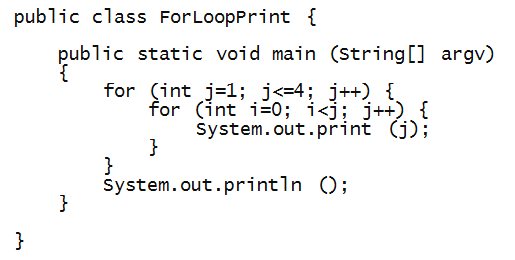By the end of this module, for simple HelloWorld-like
programs, you will be able to:
- Identify the new syntactic elements with the
basic output-only for-loop.
- Demonstrate ability to mentally trace execution of for-loops.
- Produce desired output using for-loop and printlní»s.
- Distinguish between count-up and count-down loops.
- Use some nested for-loops with independent variables.
- Use some nested for-loops with dependent conditions.
- Identify and correct syntax errors related to above objectives.
- Distinguish between syntax errors and debugging.
An example
Consider the following program:
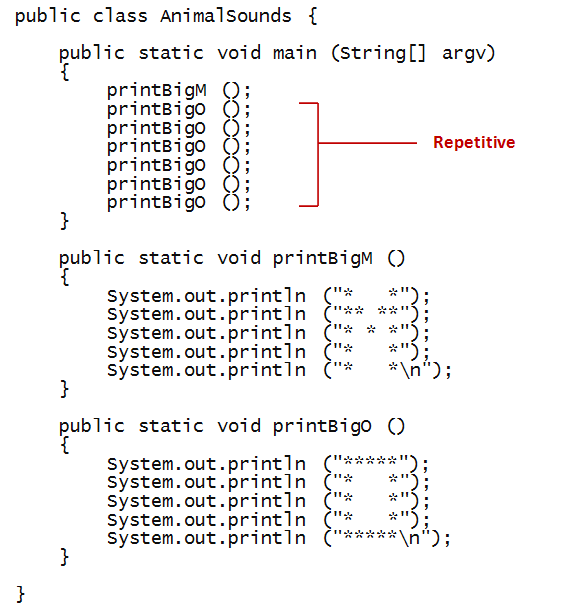
What we would like is a way to organize repetition.
We will do this using a version of the for-loop:
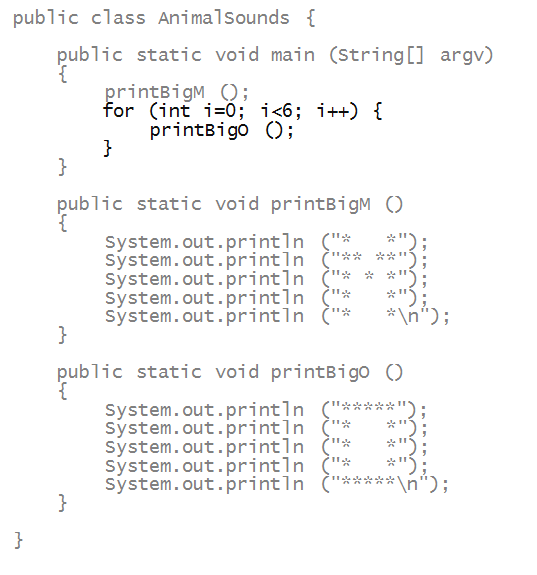
In-Class Exercise 1:
Print out your own animal sound in the above fashion
using a for-loop for some repetitive letter in the sound.
Let's zoom in on the for-loop and dissect it:
Printing the loop variable
Consider this example:
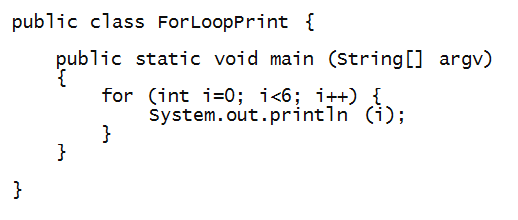
In-Class Exercise 2:
Type, compile and execute the above program. Then,
change the loop conditions so that the numbers 1 through 10
are printed. Also add a print statement after the
for-loop, that prints anything.
Observe:
- We are able to print out the for-loop variable i.
- We see that the loop is executed five times.
=> Each time the variable i has increased its value.
Mental execution:
- When execution first reaches the for-loop, the initialization
condition is executed:

- Say to yourself "i is set to 0".
- Important: the initialization condition is not executed
again, unless we somehow return to the statement preceding
the for-loop.
(We'll see later how this can happen.)
- Next, we test the re-entry condition:

- Here, you say to yourself "Is i less than 6?"
- The answer is "yes", so we enter the loop-body and execute
what's inside.
- Execute (just once) what's inside the loop body:

- In this case the value of i, which is now 0,
gets printed out.
- After the loop-body has executed, we apply
the increment

- Say to yourself "Now i has the value 1".
- Next, we test the loop-entry condition:

- Here, you say to yourself "Is i less than 6?"
- It clearly is, so we enter the loop again.
- Once again, we execute the loop body:

- Because i has the value 1, this is
what gets printed.
- Once again, we apply the increment:

- Say to yourself "Now i has the value 2".
- Next, apply the entry condition ... and so on.
- Finally, after the 5-th time through, i will
get the value 6.

- The re-entry condition now fails, and we exit the for-loop.
- What "exit" means:
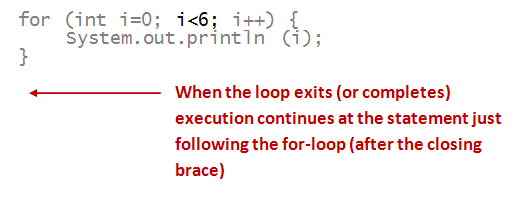
- Execution continues to just after the for-loop.
- In this program, we didn't have anything else, but
we could have had:

- In this case, you would print "MOO!" to the screen.
- Another way to understand how it works:
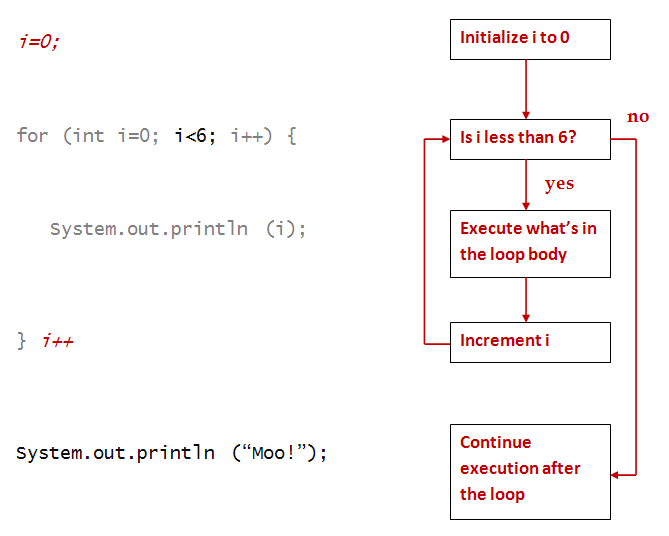
- The for-loop is one of several such strange and
fascinating creatures (structures) we'll encounter in
programming.
Variations
To explore for-loops further, we'll look at some
variations of the basic for-loop:
- First, we could have named our for-loop variable
anything we like:
for (int count=0; count<6; count++) {
printBigO ();
}
- It's customary to use short variable names like
i and j.
- To go through a loop five times, any range of numbers
will do:
for (int i=10; i<16; i++) {
printBigO ();
}
- Of course, this doesn't work for printing, unless
we want to print values from 10 to 15.
- Here's an example of using the <= operator:
for (int i=1; i<=5; i++) {
printBigO ();
}
- Treat <= as one symbol ("less than or equal to").
- We do this because the keyboard doesn't have a symbol for
≤.
- Here are different ways of incrementing by 1:
for (int i=0; i<6 i=i+1) {
printBigO ();
}
for (int i=0; i<6; i+=1) { // Using the += operator.
printBigO ();
}
In-Class Exercise 3:
Write a program to print out the odd numbers from 1 to 25.
Use a single for-loop with the appropriate increment.
- One can count down just as easily:
for (int i=5; i>0; i--) {
System.out.println (i);
}
Notice the decrement-by-one operator --.
- Observe the entry-condition is "as long as i>0".
In-Class Exercise 4:
Write a program to print out the odd numbers from 25 down
to 1.
Nested for-loops
We'll start by writing a program to print a little
number triangle like this:
1
22
333
4444
Notice: there's repetition across a row of numbers:
a potential use of for-loops!
Here's the program, using for-loops:
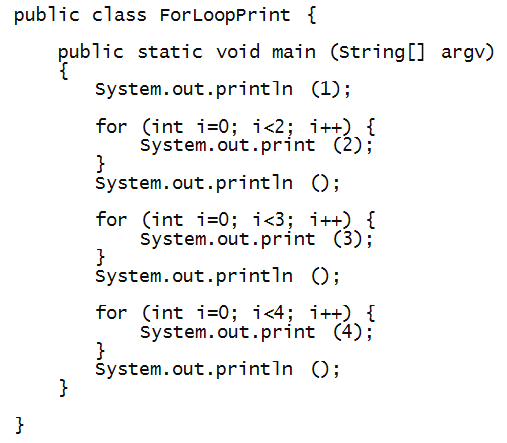
Observe:
- We've used System.out.print to avoid printing
each number on a single line.
- System.out.println() merely goes to the next line.
(Or, ends the current line being printed.)
In-Class Exercise 5:
Add a row for 5 (with five of them). Just for the
heck of it, could one use a for-loop to achieve
the printing of 1? That is, answer the
question: can a for-loop be set up so that you go
into it exactly once?
Next, observe that the upper-limits of the for-loops are
themselves increasing:
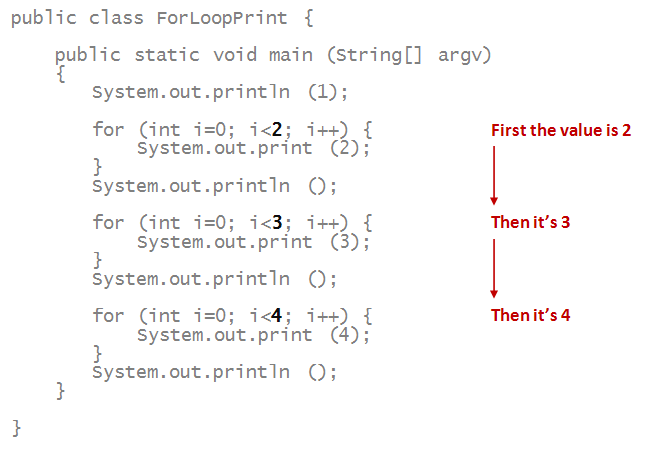
Another way to say this:
When the value is 2, print a row of 2's
When the value is 3, print a row of 3's
When the value is 4, print a row of 4's
Thus, we could try to do is:
for (int j=2; j<=4; j++) {
// Print a row of j's (j of them)
}
But we already know how to print a row of j's:
for (int j=2; j<=4; j++) {
// Print a row of j's (j of them)
for (int i=0; i<j; i++) {
System.out.print (j)
}
}
The complete program:
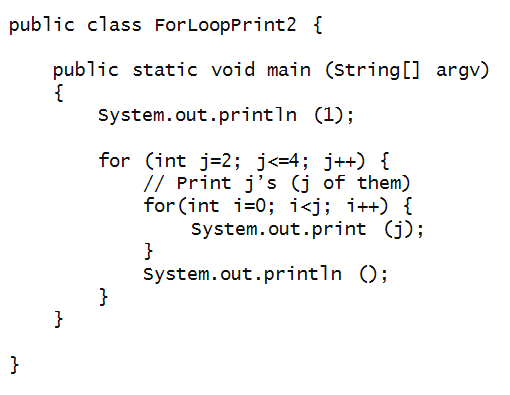
In-Class Exercise 6:
Change the program to print a fifth row
with five 5's. Then include the
row of 1's inside the loop: that is,
fix the for-loop conditions so that you don't
need the stand-alone println to print 1.
Let's point out a few more things about this example:
- The outer loop variable's value is used in the inner loop:
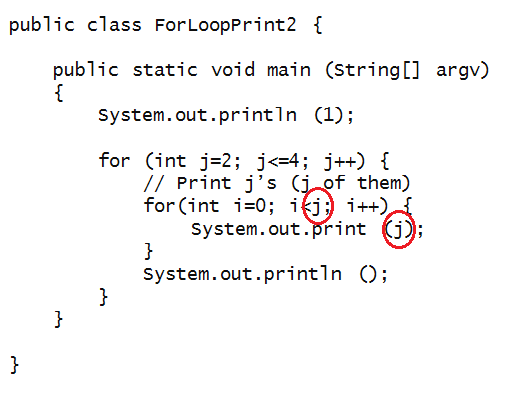
- Consider a single iteration of the outer-loop
(e.g., when j is 3).
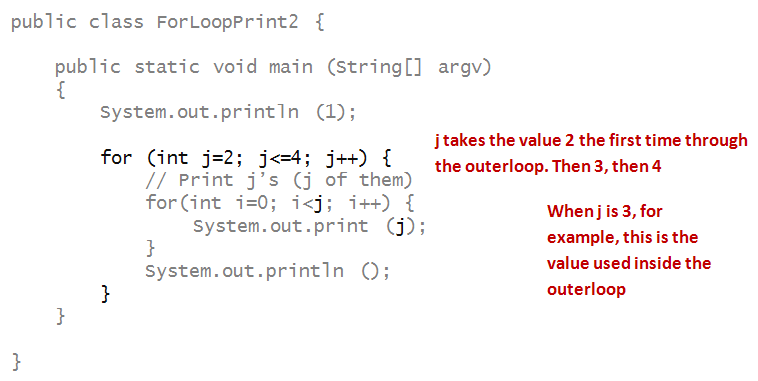
- For this value of j, the inner loop executes
j times.
- Thus, when j is 3, the inner loop
has 3 iterations.
- This is an example of a nested for-loop in
which the inner loop's execution depends on the
value of the outer-loop variable.
In-Class Exercise 7:
Trace through the execution for each possible value
of j and i.
In-Class Exercise 8:
Consider this program:
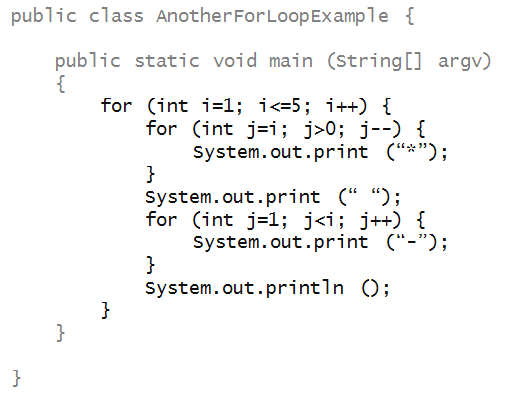
First, trace through the values of i and j by hand (using pen-and-paper)
and try to figure out what gets printed. Do this painstakingly
for each possible value of i and j. Then, edit, compile and
execute the program to see if you were right.
In-Class Exercise 9:
Write a program to print out consecutive integers in a diagonal,
as in
1
2
3
4
5
Reading and writing
Let's consider how to read a single for-loop, such as:

Writing:
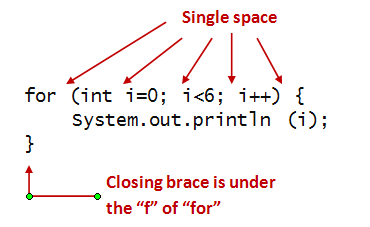
- Make sure that you stick to the conventional style.
- Again, when writing, always type matching brackets together.
In-Class Exercise 10:
Consider the following program:
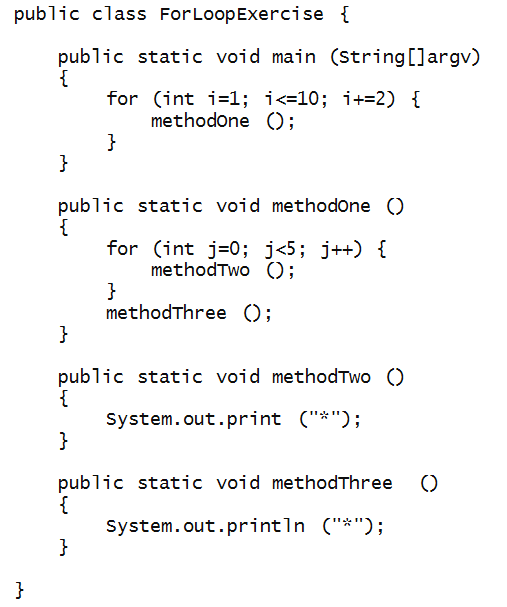
What does it print? Try to figure this out by
mental execution first. Then, type it up, compile and
execute to confirm.
When things go wrong
As code gets more complex, it gets easier to make mistakes,
and harder to find them.
In-Class Exercise 11:
In each of the programs below, try to determine
the error without compiling the program. Then,
write up the program, compile and see what the
compiler says.
Program 1:
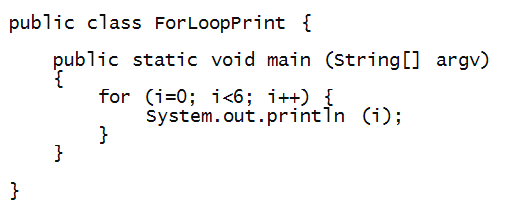
Program 2:
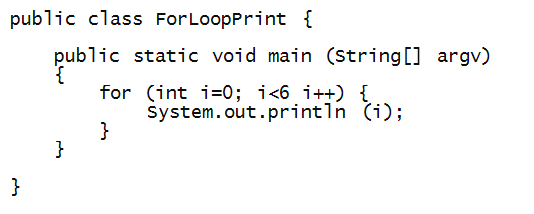
Program 3:
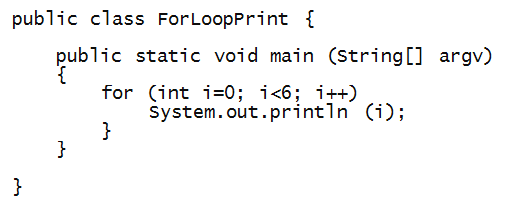
Program 4:
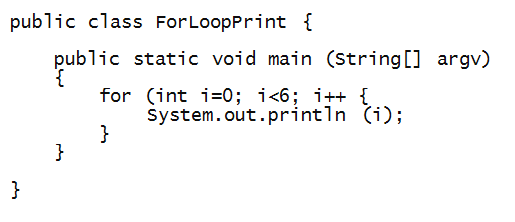
Program 5:
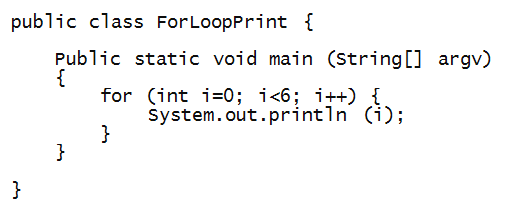
Program 6:
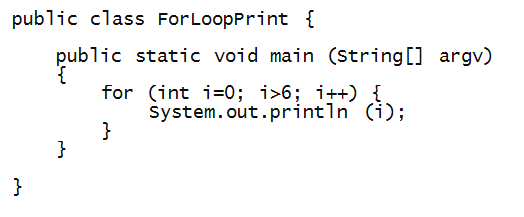
The last one is technically not a syntax error
but a logical error:
- Logical errors compile fine, but cause a problem
during execution.
- The process of identifying and fixing logical
errors is called debugging.
- A bug is a logical error.
In-Class Exercise 12:
The following program is supposed to print the triangle
of numbers:
1
22
333
4444
But there are two bugs. Type it in and see what the output
really is. Can you find the problems by reading?
